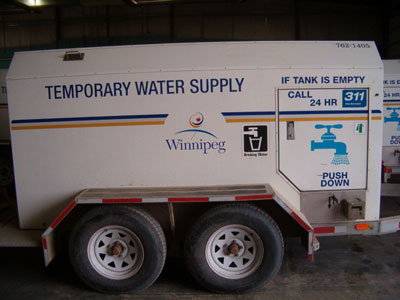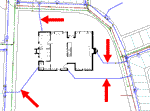Holiday season – View holiday hours for City of Winnipeg facilities and services from December 24 to January 1.
Water main activity
- Water main activity
- Water main breaks
To see if there is any water main activity in your area, visit MyUtilityInfo.
When a water main is in need of repair because of a water main break, crews will either turn the water main off or put it on reduced pressure.
Water main - off
When a water main is off, customers whose water lines are connected to the main will have no water. We may place a temporary water supply tank nearby. Water tank locations are posted on MyUtilityInfo.
If your water is off, we recommend that you keep your taps turned off to prevent water from overflowing when it is turned back on.
Once your water is back on, you may experience some discoloured water. Water main repair work changes the rate of flow of water in the distribution system. This flow change can cause sediment and minerals in the water pipes to loosen and be released into the water.
Water main - reduced flow
When a water main is on reduced flow, customers may experience low water pressure on their taps.
If a water main break is not endangering people or property, we may place the main on reduced flow so repair crews can attend to more critical breaks.
Temporary water supply tanks
Temporary water supply tanks hold 250 imperial gallons (approximately 1,000 litres) of potable drinking water. Depending on availability, water tanks are available for rent.
Temporary water supply tank locations are posted on MyUtilityInfo.
You will need to bring a container to collect the water from the tank. You can use this water as you would use the water from your tap (e.g., drinking, cooking, flushing toilets).

To get water from the tank:
- The nozzle and control handle are located near the front of the water tank. The door has a picture of a water tap on it.
- You must push down on the handle to get water.
- Water tanks are not pressurized – they are gravity flow.
If the temporary water supply tank is empty or frozen, please contact 311.
Water main breaks
Frequently asked questions (FAQ)
Water mains are underground pipes that carry water from the feeder mains to your street. Feeder mains carry the water from reservoirs and pumping stations to water mains.
Winnipeg has 2,717 kilometres of water mains.
The City of Winnipeg has installed water mains made of a variety of different materials, based on industry best practices at the time of installation. The City has:
| Water Mains | Feeder Mains | |
|---|---|---|
| Concrete | - | 119 km (79%) |
| Cast or ductile iron | 520 km (19%) | - |
| Asbestos Cement | 696 km (26%) | 23 km (15%) |
| PVC | 1,413 km (52%) | 6 km (4%) |
| Unknown or miscellaneous material | 88 km (3%) | 3 km (2%) |
| Total | 2,717 km (100%) | 151 km (100%) |
Both the World Health Organization and Health Canada have completed research on ingestion of asbestos fibers in drinking water that indicates no guideline is required. The US Environmental Protection Agency does recommend a guideline, based on the length of asbestos fibers. Fibers shorter than 10 μm have no recommended limit, but fibers longer than 10 μm have a recommended limit of 7 million fibers per litre. When Winnipeg was testing for asbestos over 11 years from 1981-1995, there were no fibers longer than 10 μm found. Given the lack of evidence of negative outcomes from ingesting asbestos, and the fact that our drinking water always met the United States Environmental Protection Agency, World Health Organization, Health Canada and the Province of Manitoba standards, testing was discontinued.
The risk from AC pipes is due to inhalation when they are cut during repair or replacement. The City has strict procedures for minimizing this risk. The City replaces water pipes when they no longer meet their level of service, this includes AC pipes. As a result, our inventory of AC pipe is reduced every year. Structurally, the AC pipe inventory is performing well and has not experienced significant corrosion, and it is less likely to release fibers as it hardens with age.
Also, the City’s water system uses orthophosphate to stabilize the interior of pipes for lead control. This coating also reduces the potential for asbestos fiber release.
Contact 311 or visit MyUtilityInfo to view all nearby repair work.
The water will usually find its way to the surface. Because the water main is under pressure, water will continue to flow until the break is controlled.
Water main breaks usually result from external corrosion of the pipe. Winnipeg soil is highly conductive and corrodes the metallic pipe from the outside in. Extreme weather changes can cause the ground to swell and contract, placing excessive pressure on the water mains, causing any weakened pipe to break.
Water main breaks can be impacted by weather. Long periods of wet or dry weather will change soil moisture conditions, which causes ground swelling and contracting, putting stress on pipes. Frost depth in winter can impact pipes, but our water mains are generally installed 8 feet (2.4m) deep, which is below a normal winter frost depth. Typically, we experience just as many water main breaks in the summer as we do during the winter.
During the winter, water main breaks are more visible and more difficult to repair. When it's cold outside, the water leaking from the broken main quickly freezes instead of draining into nearby catch basins, causing icy road and sidewalk conditions. The ground is also frozen, making it harder for crews to excavate and access the broken pipe.
In 2023, we had 378 water main breaks. At our worst point in the 1980s, we were averaging 2,100 water main breaks a year, or about 6 breaks a day. The worst year for water main breaks was 1983 with 2,549 breaks. We now have an average of about 1 or 2 breaks a day.
Up to four crews work 7 days a week, 11 hours per day repairing water main breaks, leaking or broken valves, and broken services. We also have 2 crews working in Emergency Services 7 days a week, 24 hours a day, so we can respond to water main breaks any time of the day or night.
Once we receive a notice from our 311 Centre about a water main break, we:
- Dispatch a crew to the location.
- Control the leak to reduce the risk to public safety, and private and public property. We do this by finding and closing valves.
- Contact other utilities to make sure that we can dig without damaging other services or endangering staff or the public.
- Pinpoint the location of the leak using an electronic leak detector.
- Dig down to the water main and confirm the cause of the leak.
- Repair the water main. Depending on the type of break, we may apply a repair clamp or replace a length of pipe.
- Open valves to turn the water main back on, flush the water main and sample water quality.
- Backfill to temporarily restore the excavated area.
- Permanently restore the sod or pavement in the excavated area.
If there are no complications, we can usually repair a water main within 24 hours. If the break is not creating problems, we may leave the water main on while repair crews attend to more critical breaks.
We prioritize the repairs based on the potential for damage or hardship. At the top of our list are:
- critical customers (e.g., hospitals, nursing homes),
- breaks which affect a large number of people (e.g., apartment blocks, institutions, schools), and
- major roads.
Every year, we replace aging water mains as part of our water main renewal program to help reduce the number of water main breaks.
Water main break on your street
Contact 311.
There usually isn't time to notify residents. The water can flood streets and private property causing damage and safety hazards, and must be controlled as quickly as possible.
Water is sometimes discoloured after water main breaks, but this should not last long. Do not use discoloured water for any purposes that require clean water, such as preparing food and beverages, medical and dental procedures, or laundry.
- Turn on a cold water tap and let the water run for a few minutes. Do not choose a tap that has a water filter connected to it, or the sediment may clog your filter. Do not use a hot water tap because it could draw sediment into your hot water tank.
- Catch some water in a light-coloured cup or container to see if it is clear. You can use your water if it is clear.
- If the water doesn't clear in 5 minutes, wait 30 minutes and try again.
We may provide a water tank with emergency drinking water for homes and apartments. You will need to bring a container to collect the water from the tank. You can use this water as you would use the water from your tap (e.g., drinking, cooking, flushing toilets). If the tank gets low, contact 311 and we will refill it.
As a temporary solution, we may be able to supply and install a temporary hose line:
- if a fire hydrant is available,
- if a hose line is available, and
- if the hose line does not unreasonably interfere with traffic.
The fee for this service is listed on the City of Winnipeg's online utility billing service, MyUtility.
You can consider a permanent solution by installing a second service line:
- to a different water main (select figure 1 to see a larger version)
- to the same water main with a valve on the water main between the services.
(select figure 2 to see a larger version)
 Figure 1 |
 Figure 2 |
All food service establishments must be connected to the City's water supply in accordance with the applicable legislation. This requirement is to ensure that proper hand washing, utensil washing and toilet facilities are available at all times during the business operating hours. This means that if there is an interruption in the water service to your establishment, you must purchase a temporary hose line in order to remain open.
You can see the Food and Food Handling Establishments Regulation, emergency action plans and other helpful documents:
On occasion, a property can be flooded due to a water main break. We do everything we can to prevent this, but sometimes there are circumstances beyond our control that can result in property flooding, such as:
- homes that are very close to a major street with a large water main, or
- water that can't drain in winter because the catch basins are frozen.
We understand that this can be very disruptive and frustrating to property owners, and we regret the damage that can occur.
Consult your insurance provider to be sure you are protected by your property insurance policy. Insurance for damages caused by water main breaks is included in most residential and commercial property insurance policies.
Ensure your home is safe.
Yes, you can file a claim by contacting 311. However, under Section 485 of
The City of Winnipeg Charter, the City is not liable for loss or damage as a result of a break or malfunction of a water main unless it is established that the break, malfunction or failure was the result of the negligence of the City or its employee. Similar legislation exists for almost all water utilities in North America.
